ASRock M8 Barebones Review: My Steam Box
by Ian Cutress on January 2, 2014 10:00 AM EST- Posted in
- Barebones
- Intel
- ASRock
- Motherboards
- Cases/Cooling/PSUs
- Z87
Because it can be difficult to benchmark a barebones, due to our choice in hardware overriding any performance results, I wanted to run my usual CPU benchmark suite to at least indicate where a CPU such as the i7-4765T would perform, given its lower CPU MHz base (2.0 GHz) but highly multithreaded nature. The CPU itself performs well, and outstretches almost all the AMD CPUs in every benchmark, sometimes being eclipsed by the FX-8350 in specific workloads.
Point Calculations - 3D Movement Algorithm Test
The algorithms in 3DPM employ both uniform random number generation or normal distribution random number generation, and vary in various amounts of trigonometric operations, conditional statements, generation and rejection, fused operations, etc. The benchmark runs through six algorithms for a specified number of particles and steps, and calculates the speed of each algorithm, then sums them all for a final score. This is an example of a real world situation that a computational scientist may find themselves in, rather than a pure synthetic benchmark. The benchmark is also parallel between particles simulated, and we test the single thread performance as well as the multi-threaded performance.
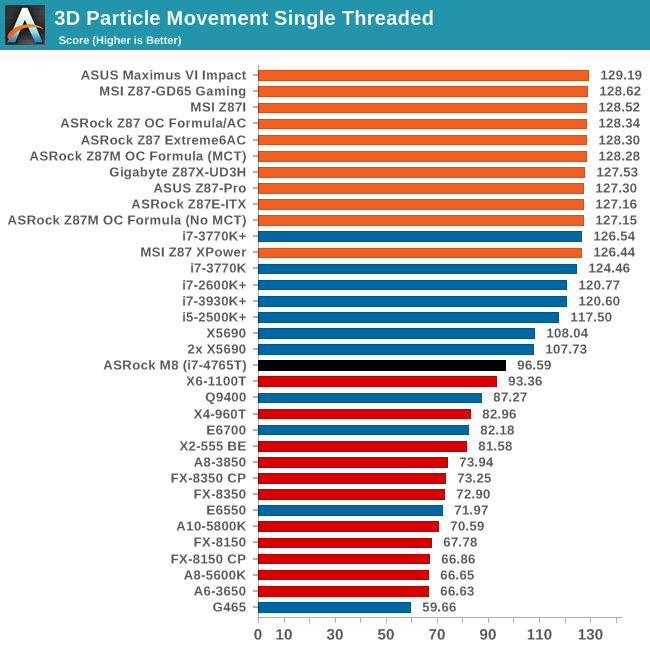
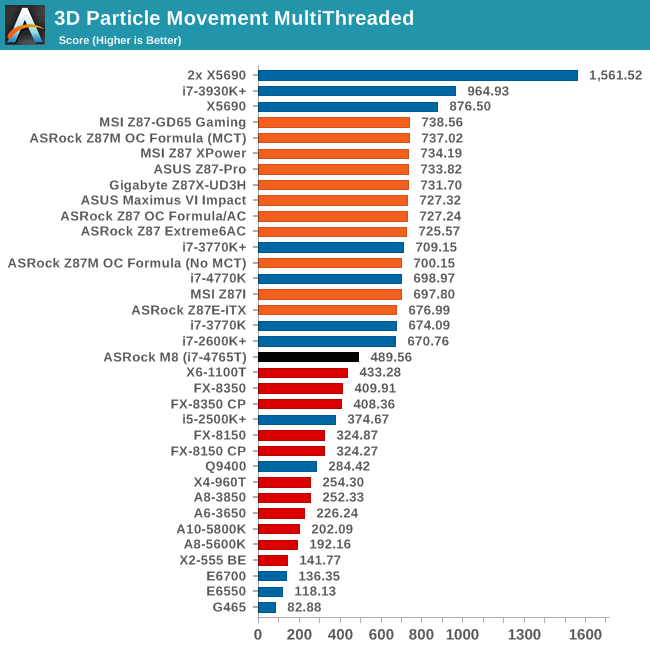
Compression - WinRAR 4.2
With 64-bit WinRAR, we compress the set of files used in the USB speed tests. WinRAR x64 3.93 attempts to use multithreading when possible, and provides as a good test for when a system has variable threaded load. WinRAR 4.2 does this a lot better! If a system has multiple speeds to invoke at different loading, the switching between those speeds will determine how well the system will do.

Image Manipulation - FastStone Image Viewer 4.2
FastStone Image Viewer is a free piece of software I have been using for quite a few years now. It allows quick viewing of flat images, as well as resizing, changing color depth, adding simple text or simple filters. It also has a bulk image conversion tool, which we use here. The software currently operates only in single-thread mode, which should change in later versions of the software. For this test, we convert a series of 170 files, of various resolutions, dimensions and types (of a total size of 163MB), all to the .gif format of 640x480 dimensions.
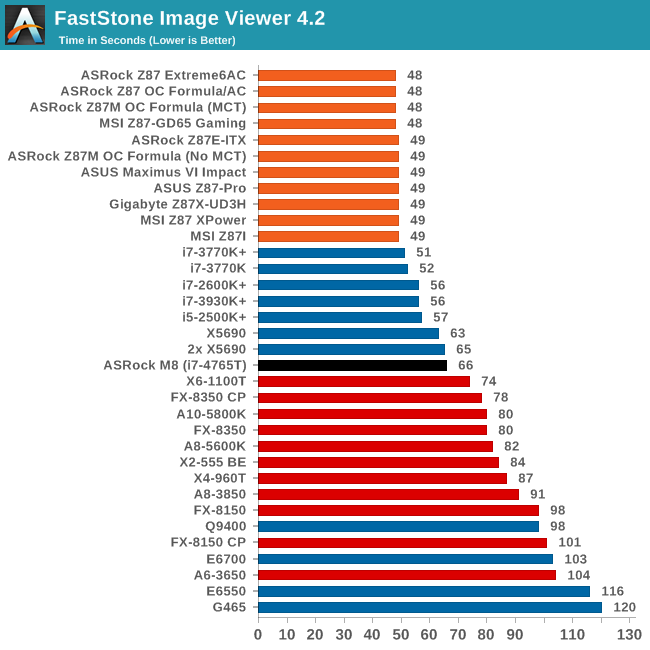
Video Conversion - Xilisoft Video Converter 7
With XVC, users can convert any type of normal video to any compatible format for smartphones, tablets and other devices. By default, it uses all available threads on the system, and in the presence of appropriate graphics cards, can utilize CUDA for NVIDIA GPUs as well as AMD WinAPP for AMD GPUs. For this test, we use a set of 33 HD videos, each lasting 30 seconds, and convert them from 1080p to an iPod H.264 video format using just the CPU. The time taken to convert these videos gives us our result.
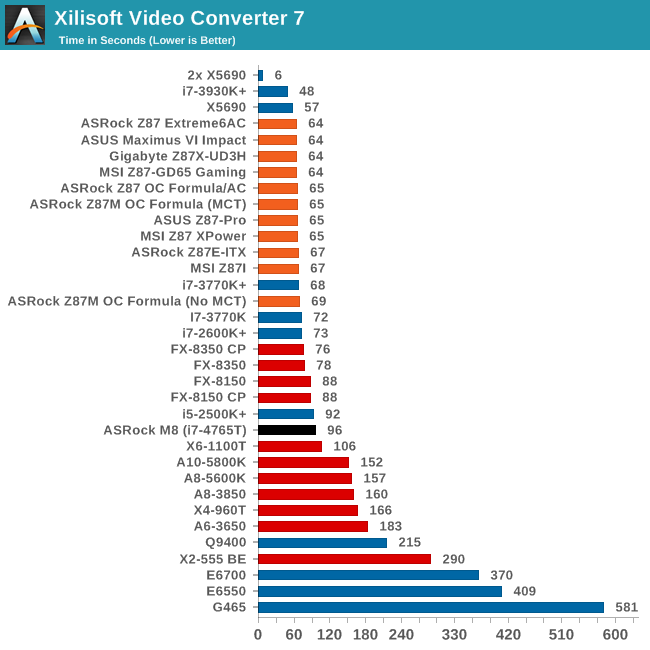
Rendering – PovRay 3.7
The Persistence of Vision RayTracer, or PovRay, is a freeware package for as the name suggests, ray tracing. It is a pure renderer, rather than modeling software, but the latest beta version contains a handy benchmark for stressing all processing threads on a platform. We have been using this test in motherboard reviews to test memory stability at various CPU speeds to good effect – if it passes the test, the IMC in the CPU is stable for a given CPU speed. As a CPU test, it runs for approximately 2-3 minutes on high end platforms.

Video Conversion - x264 HD Benchmark
The x264 HD Benchmark uses a common HD encoding tool to process an HD MPEG2 source at 1280x720 at 3963 Kbps. This test represents a standardized result which can be compared across other reviews, and is dependent on both CPU power and memory speed. The benchmark performs a 2-pass encode, and the results shown are the average of each pass performed four times.
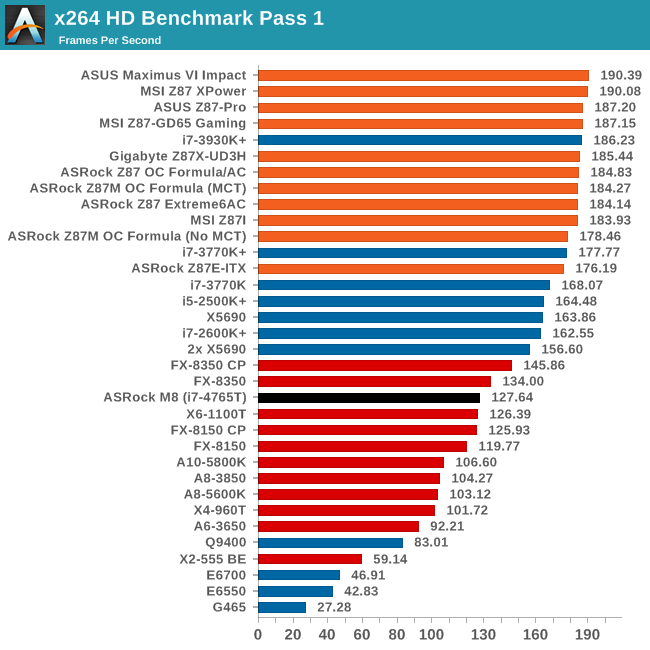
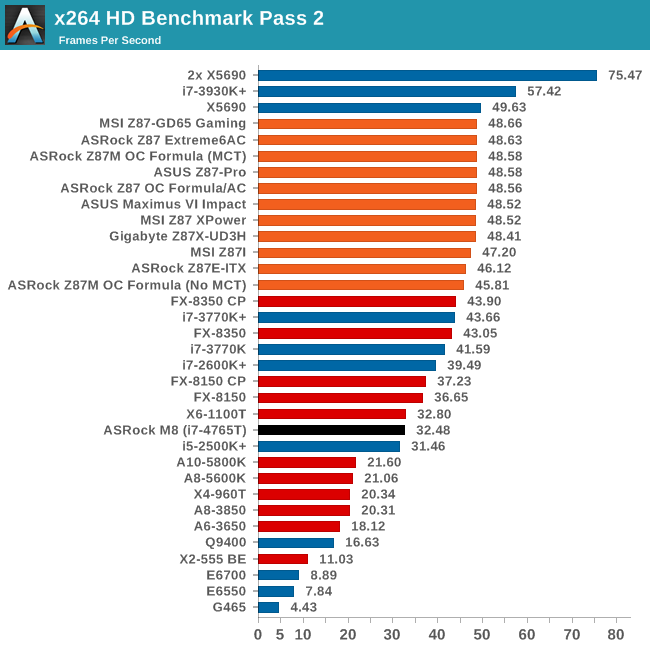
Grid Solvers - Explicit Finite Difference
For any grid of regular nodes, the simplest way to calculate the next time step is to use the values of those around it. This makes for easy mathematics and parallel simulation, as each node calculated is only dependent on the previous time step, not the nodes around it on the current calculated time step. By choosing a regular grid, we reduce the levels of memory access required for irregular grids. We test both 2D and 3D explicit finite difference simulations with 2n nodes in each dimension, using OpenMP as the threading operator in single precision. The grid is isotropic and the boundary conditions are sinks. Values are floating point, with memory cache sizes and speeds playing a part in the overall score.
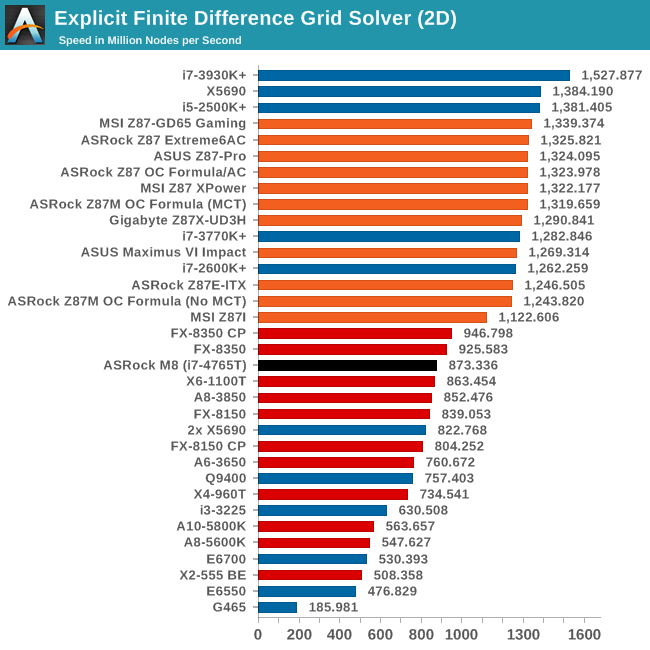
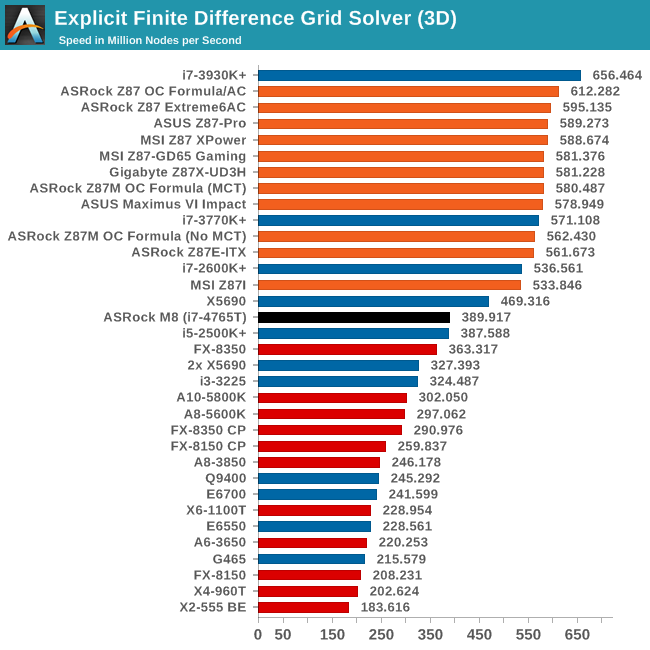
Grid Solvers - Implicit Finite Difference + Alternating Direction Implicit Method
The implicit method takes a different approach to the explicit method – instead of considering one unknown in the new time step to be calculated from known elements in the previous time step, we consider that an old point can influence several new points by way of simultaneous equations. This adds to the complexity of the simulation – the grid of nodes is solved as a series of rows and columns rather than points, reducing the parallel nature of the simulation by a dimension and drastically increasing the memory requirements of each thread. The upside, as noted above, is the less stringent stability rules related to time steps and grid spacing. For this we simulate a 2D grid of 2n nodes in each dimension, using OpenMP in single precision. Again our grid is isotropic with the boundaries acting as sinks. Values are floating point, with memory cache sizes and speeds playing a part in the overall score.
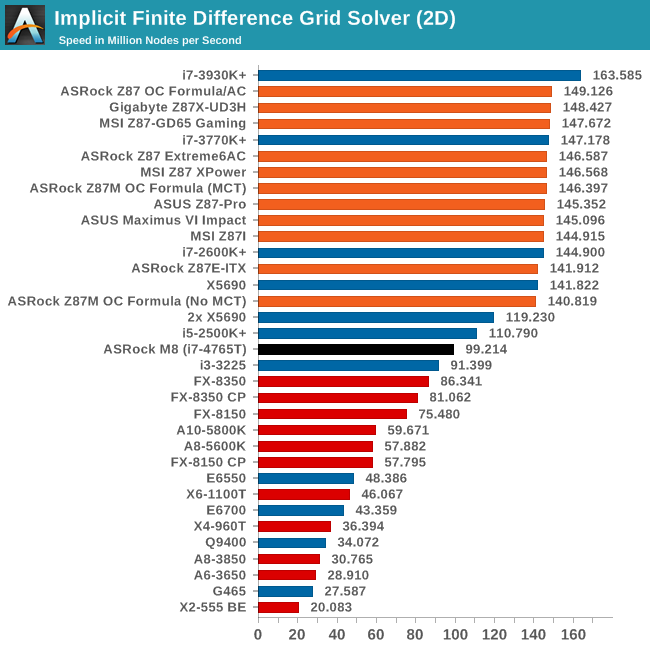
Point Calculations - n-Body Simulation
When a series of heavy mass elements are in space, they interact with each other through the force of gravity. Thus when a star cluster forms, the interaction of every large mass with every other large mass defines the speed at which these elements approach each other. When dealing with millions and billions of stars on such a large scale, the movement of each of these stars can be simulated through the physical theorems that describe the interactions. The benchmark detects whether the processor is SSE2 or SSE4 capable, and implements the relative code. We run a simulation of 10240 particles of equal mass - the output for this code is in terms of GFLOPs, and the result recorded was the peak GFLOPs value.
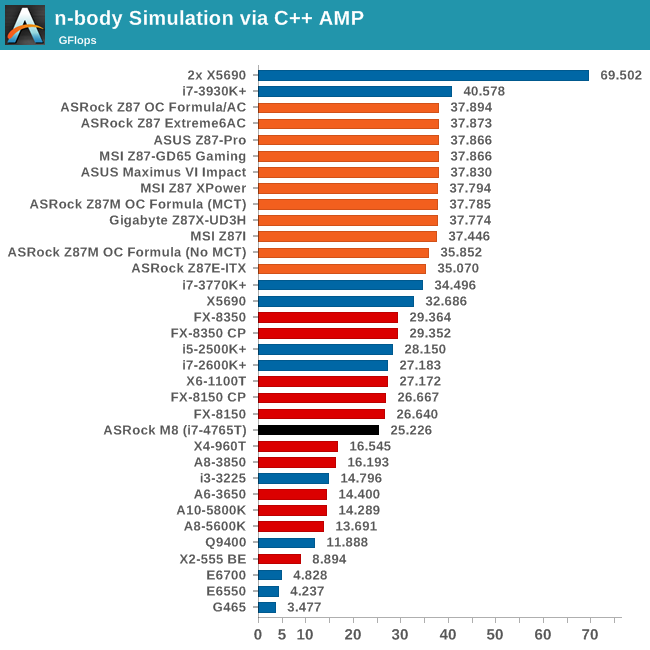










78 Comments
View All Comments
eanazag - Friday, January 3, 2014 - link
I'd rather not talk about the AMD APU option till they release their new APUs. We are so close to the scheduled launch dates.PreciseInteli - Thursday, January 2, 2014 - link
These smaller builds are exciting. Just helped a friend build a Mini-ITX build with a 290x ... incredibly jealous ... still with a huge tower here.I'd like to see you guys push this slightly further with a card like the Sapphire Radeon R9 290 Tri-X or 780. These cards thermal limit themselves anyways ... I think it could be interesting.
Babar Javied - Saturday, January 4, 2014 - link
I hear you man. I still have a Corsair 800D and though I do love the case, it is f*%$ing huge. I've been considering opting for an m-itx for sometime now.jhoff80 - Thursday, January 2, 2014 - link
Love the design of the case, but as for the exterior, it looks terrible to me. I don't know why nobody is currently making a case in this layout that has a subtle exterior suitable for a living room (Silverstone's upcoming looks variant cheap and plasticy).These (in my opinion) gaudy gamer-style cases just don't really make sense for a Steambox alternative; even Valve themselves knew to use a subtle black case.
rocktober13 - Thursday, January 2, 2014 - link
I just put together a Mini-ITX build with the EVGA Hadron Air and the ASRock Z87E-ITX. It ends up being less than $400 for a similar "barebones" setup as the M8. Also, I think the Hadron looks great (black and sleek), is smaller than the M8, and it's a really well put together considering it's EVGA's first case.jhoff80 - Thursday, January 2, 2014 - link
Agreed, that looks nice, but what I really want something is horizontal / component -style to fit in my TV stand.Temporarily, I'm using a Coolermaster Elite 120, but I'd rather something that looks like the Steambox (except maybe with a front LED that is MUCH dimmer than that one).
DARBYOTHRULL - Thursday, January 2, 2014 - link
I agree, where the cases that don't say "I'm twenty-two years-old".patterson32 - Friday, January 3, 2014 - link
More like "I'm 10 and I'm cool!" It's really hard trying to find a nice looking case. They're either very cheap looking or they're made for 10 year olds. LEDs, case windows, bright colors, etc. are very ugly looking and screams "I'm a kool kid!" The only thing that looks nice about this thing is the matte finish.smartypnt4 - Friday, January 31, 2014 - link
I completely agree. Then you find a case that looks awesome and you find out it doesn't meet your specs that you would like. Specifically, apparently the combination of 11-12" GPU combined with a 650W PSU in a small mITX (read: EVGA Hadron Air or smaller) that looks halfway decent is impossible to find. I really like the SilverStone FT03-Mini, but it's limited to SFX power supplies. The EVGA Hadron Air is great, but 500W isn't enough for ideally what I'd want, nor does it allow for >10.5" video cards.C'est la vie, eh? Nothing is ever perfect for what I'd like.
SunLord - Thursday, January 2, 2014 - link
That power cord connector looks like the standard one that comes with most pc laptop power blocks for the last few years my three hp and one gateway all have that plug